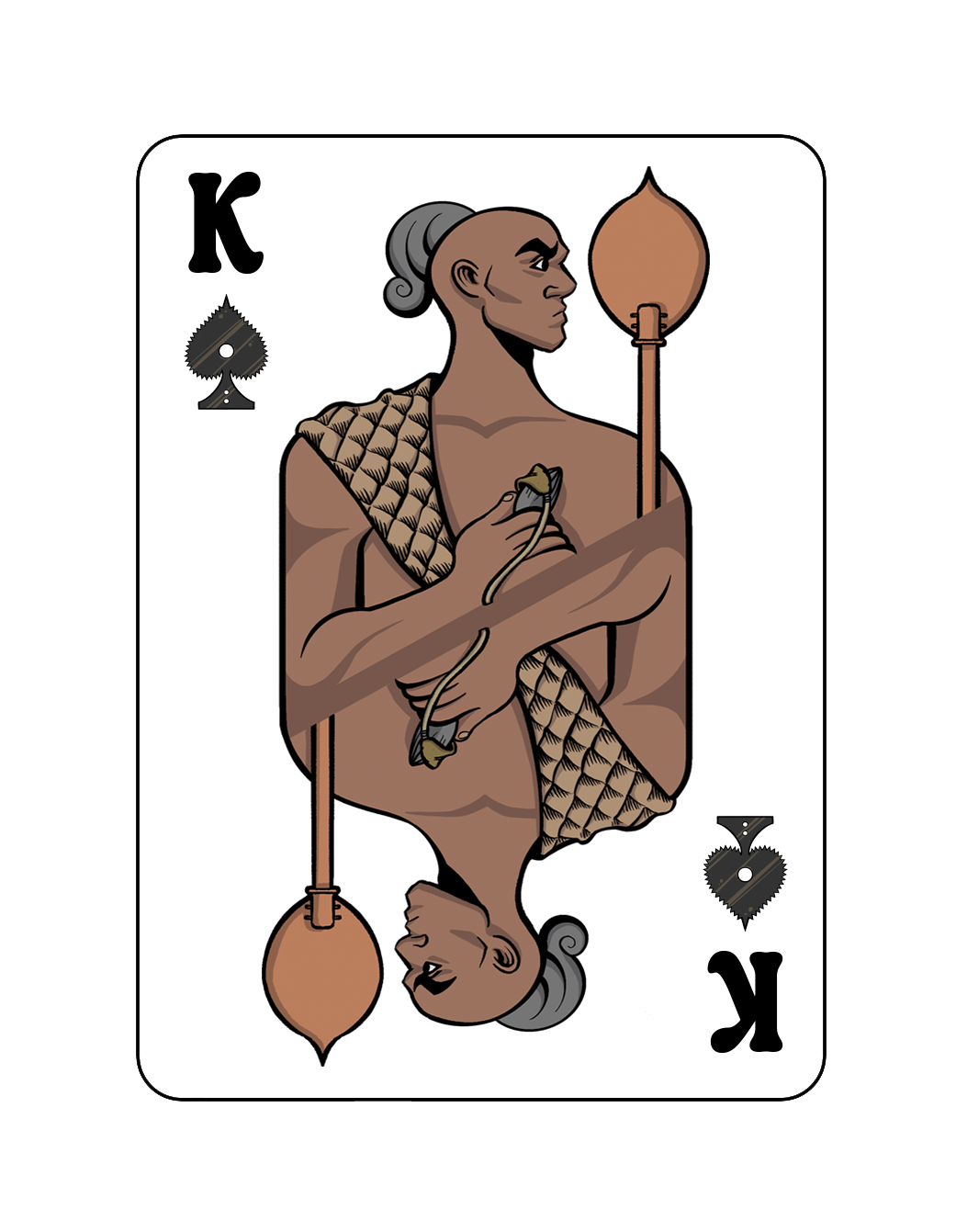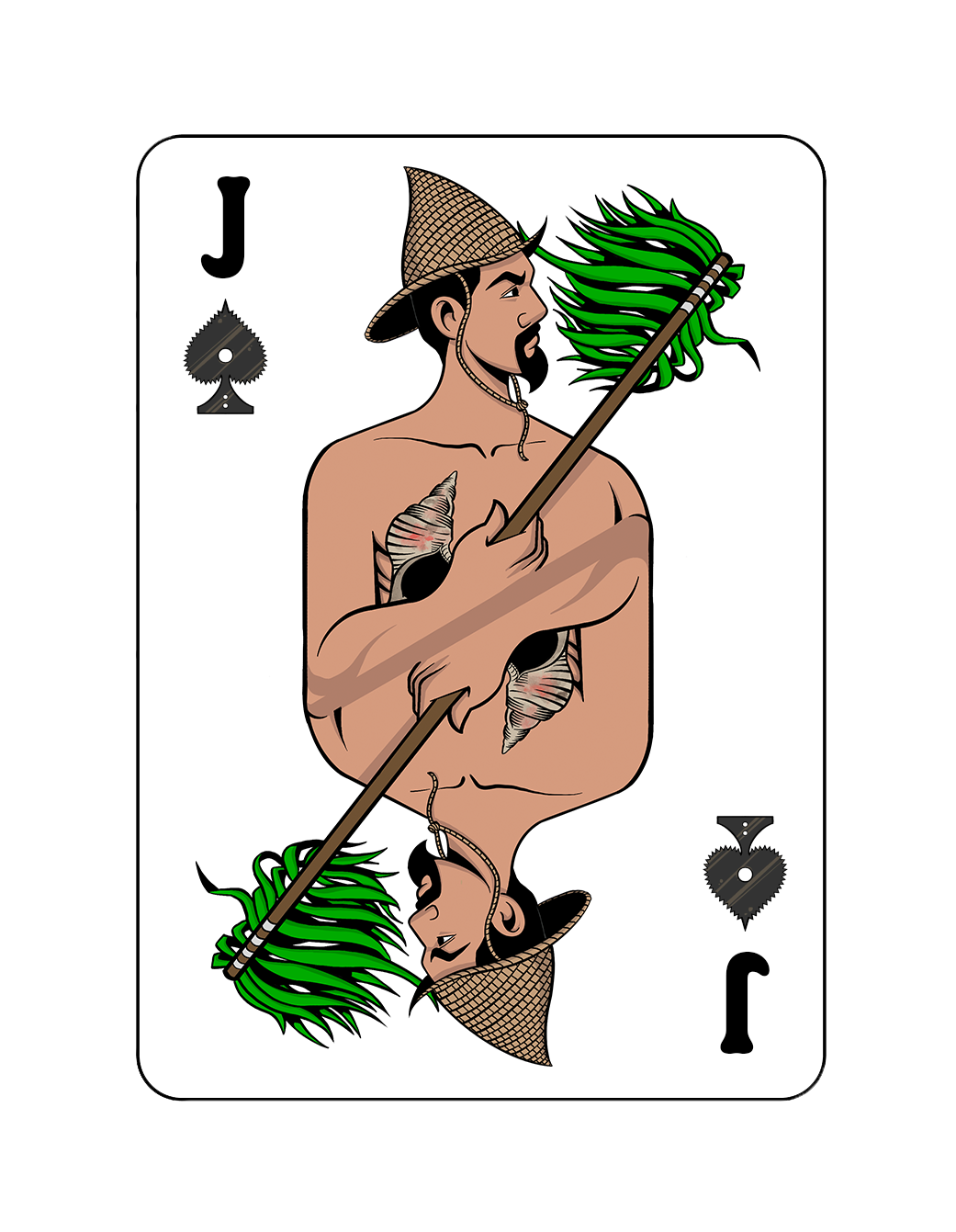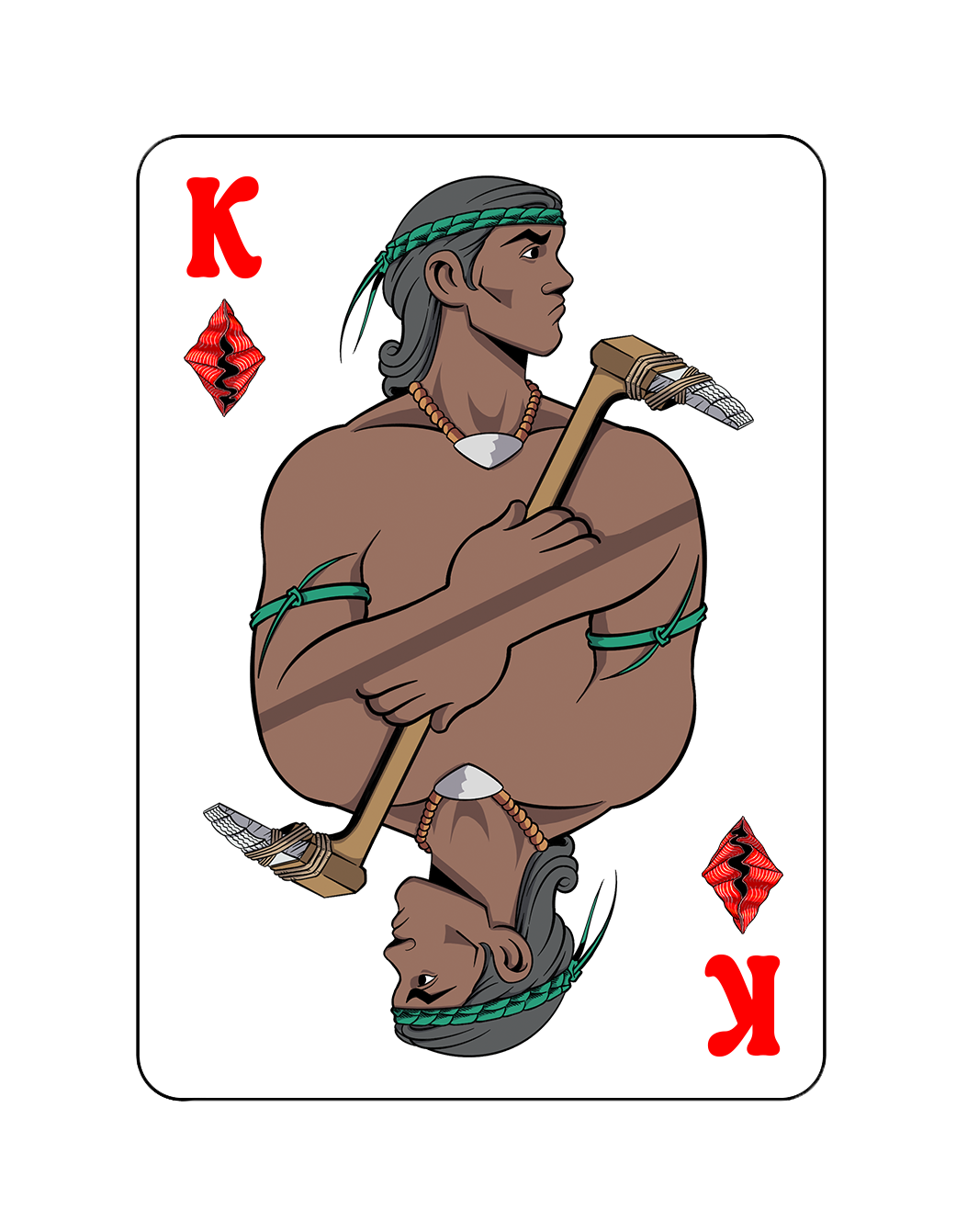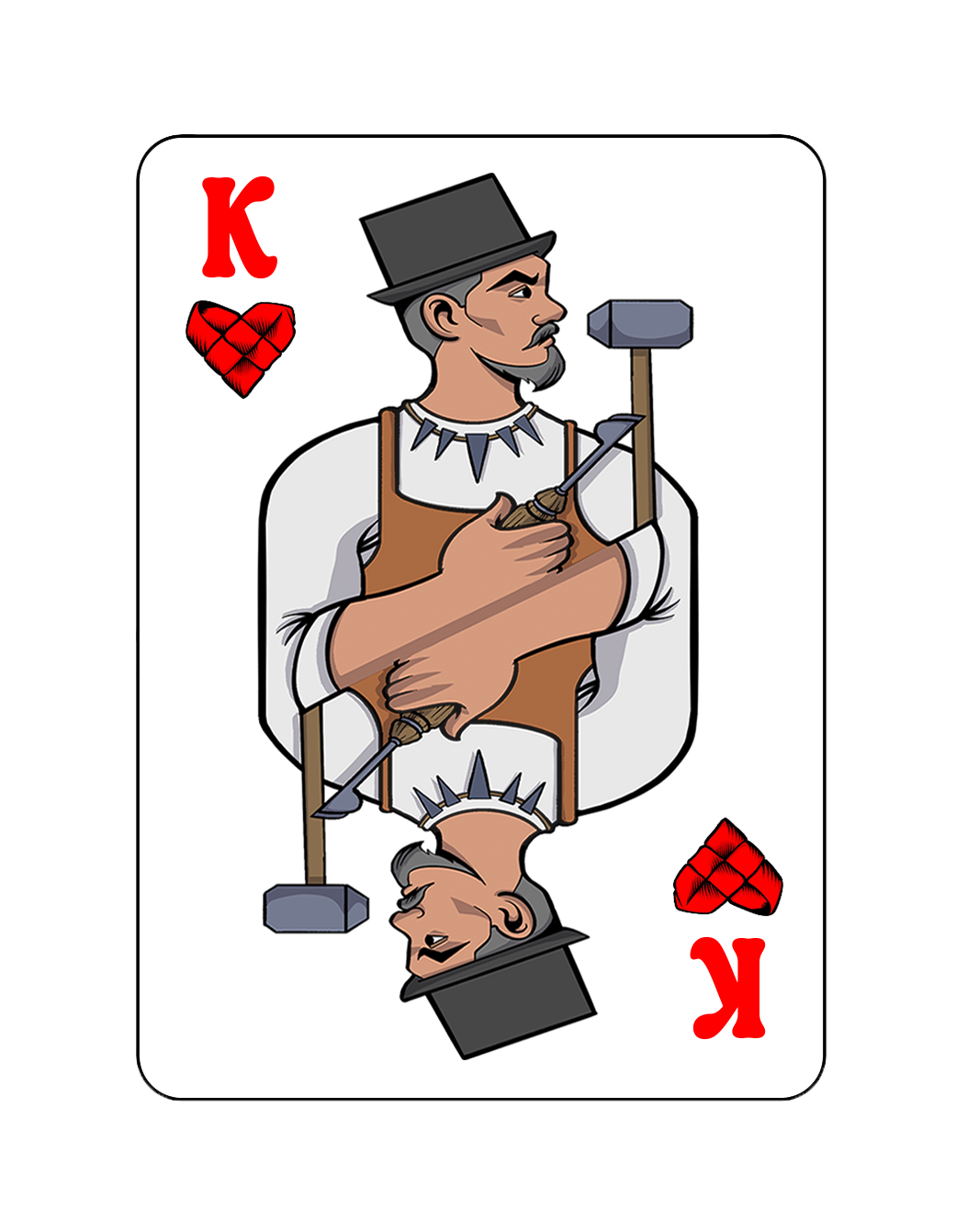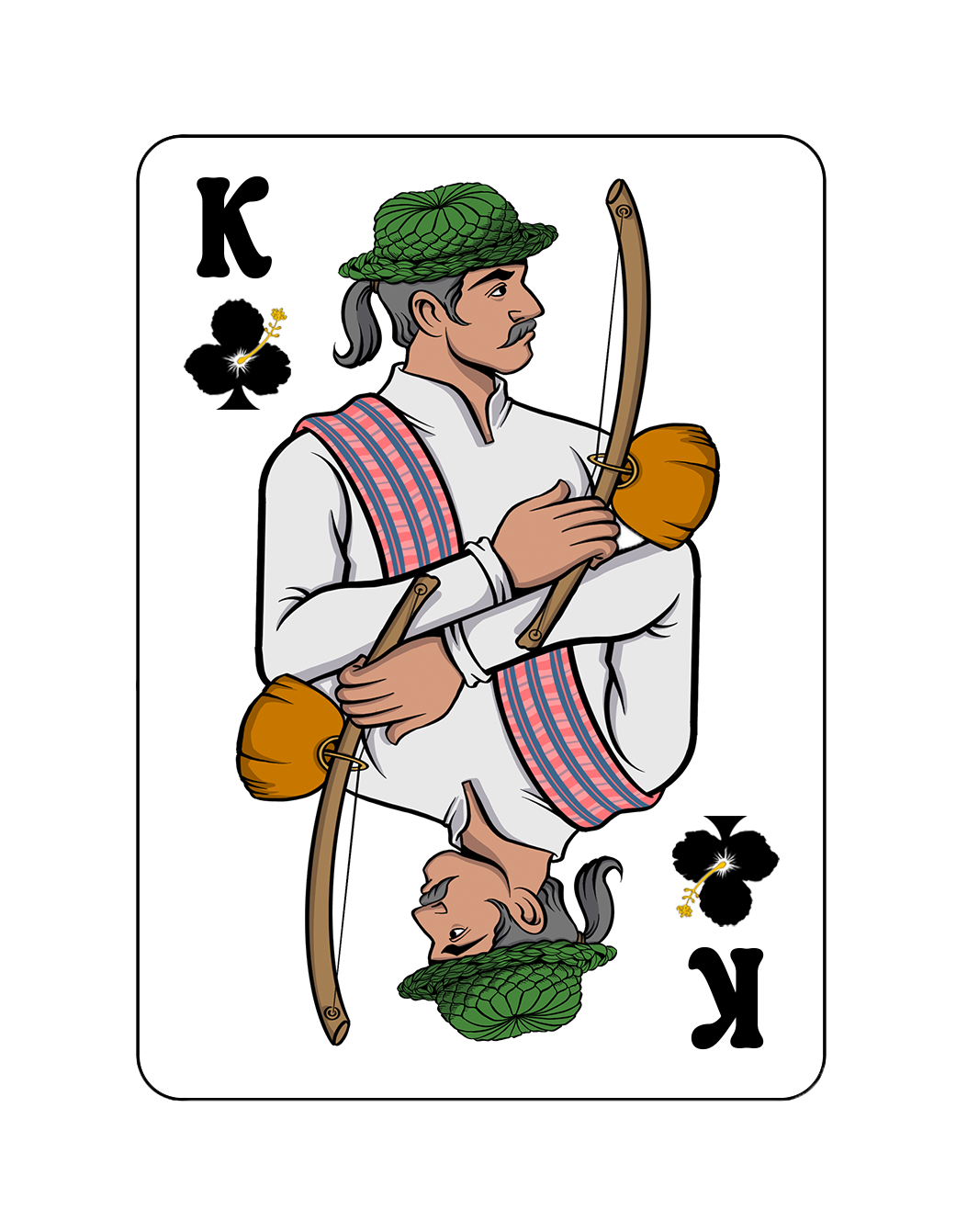The CHamorri
In Ancient CHamoru society, the CHamorri was the upper caste made up of two groups - the matao and the acho’at. The Ancient CHamoru Kings, Queens, Jack, and Jill (below) in our deck represent these two groups and this is our interpretation royalty and nobility during the Pre-Colonial Era:
The King of Spades is a maga’låhi (male chief or first-born son) of his clan or village and master navigator of the sakman (flying proa) and is an adept kasadules and peskadot (hunter and fisherman). He is outfitted with a woven sash and holds both a paddle, an atupat, and åcho’ atupat (sling and sling stone).
The Queen of Spades is a maga’håga’ (female chief or first-born daughter) of her clan or village. She is skilled warrior and master chanter adorned with turtle shell jewelry and befriended by a Marianas Fruit Dove and holding a clay pot with lemmai (breadfruit), mango, and bilembinas (star apple/fruit). She styles her hair like her fellow manmaga’låhi because of her prowess is equal to that of her male counterparts.
The Jack of Spades holds a baobao (banner, flag, guidon, etc.). He has a ku’lo (conch) nestled against his body. His role is to call people for mass gatherings whether for mourning, celebration, signal an upcoming battle. He will also lead his clan or village.
The King of Diamonds is another clan’s or village’s maga’låhi as well as a master farmer, carver, and canoe builder. He holds an adze (shell digging tool) and is outfitted with woven accessories as well as the sinåhi (new moon) necklace made from giant clam.
The Queen of Diamonds is our seafaring maga’håga’ (female chief / first born daughter). She is a master fisherman displaying her recent catch of parrotfish and flying fish accompanied by the sihek (Marianas Kingfisher). Powdered limestone has caused her hair to lighten. She wears a gaosåli (Trumpet Flower / Torchwood) crown and a purple spondylus necklace.
The Jill of Diamonds wears her hair down to her lower back and accessorizes with a spondylus bracelet. She holds a woven basket filled pugua (betel nut), pupulu (pepper leaf), and her animal che’lu (sibling), the ko’ko’ (Guam Rail). Although she is not a maga’håga’ she still plays a vital role in family affairs and decision-making for her clan or village.
The Principalia replaced the CHamorri during the Spanish Colonial Era. An elite group called the mannakilo’ (high class) emerged from the prinicipalia. They were comprised of 12 families born from CHamoru nobility who intermarried with the Spaniards, learned Spanish (while still maintaining CHamoru), and practiced Catholicism. Additionally, they were given civic duties and owned property. Below is our interpretation of CHamoru Spanish royalty and nobility:
The Principalia
The King of Hearts is a master herrero (blacksmith). He holds a blacksmith hammer, coconut extractor, and wears an si’i (weaver’s tool) necklace. His skills places him and his family in a higher status through artisanry and invaluable expertise.
The Queen of Hearts is a master weaver wearing a mestiza, a traditional CHamoru dress with Spanish and Filipino influences. She amplifies prestige by placing a hibiscus in her hair, wears Seven Day bracelets with bamboo etchings, and dons a pearl necklace with the visage of our CHamoru patroness saint, Santa Maria Kamalen.
The Jack of Hearts is a whaler. In his hands he holds a whale harpoon and in his arms is a jar of tuba (coconut liquor/moonshine).
The King of Clubs is a master belembaotuyan (a hallow gourd instrument) player. He wears a traditional woven coconut leaf hat and is distinguished by his pastel colored sash. These colors were favored by Spanish nobility at that time.
The Queen of Clubs is a techa’ (traditional female prayer leader). She holds a woven cross for Palm Sunday, wears a scapular, and places a veil lined with Bulbophyllum orchid patterns on her head. She is blessed with the presence of Marianas 8 spotted butterflies.
The Jill of Clubs sings her devotions to God with her partner, the CHichirika (Rufus Fantail) while wearing a lisayo (rosary) and holding a book of Psalms.
The Jokers
The female Joker is an homage to our makåhna (spiritual leaders), suruhåna (herbal healers), and manåmko (elderly). Men are also suruhånus or makåhnas, however, we wanted to dedicate this card to women. The makåhna / suruhåna has a vast knowledge of local medicines and have a connection with the taotaomo’na (Ancient CHamoru spirits). This card in essence is our ancient CHamoru high priestess. She is holding a stone pestle to mix medicinal concoctions (on her right side) such as the Beach Morning Glory and the noni (indian mulberry). She is revered with a variation of a Maku dudu (polished turtle shell plate) and a spondylus necklace with shark teeth extensions for her wisdom, guidance, expertise, and strength to her community. The taotaomo’na behind were given a neutral expression because taotaomo’na range from friendly, playful, or even vengeful depending on how one behaves in their spaces. Respect goes a long way in CHamoru culture for both the living and the dead.
The male Joker is none other than Juan Mala, the CHamoru frihonådu, sålåmånka, chånseru (joker, jokerster, trickerster, etc.). He is holding a “magical” lemonchina (bergamot) branch and his “earned” bag of coins. Don’t be fooled by his smile!
To view his full story, please click on this link: Juan Mala
